╔
Crecimiento del Trabajo Femenino en la Pesca Artesanal: Desafíos de la Experiencia Chilena
Durante los últimos 20 años en Chile, un país con 6.435 km de costa [5], la pesca artesanal ha pasado de ser una actividad tradicional, con poco uso de tecnología y centrada en ámbitos locales con un reducido aporte a la economía nacional, a ser un sector de importancia territorial, regional y nacional, trascendiendo incluso con sus recursos a mercados internacionales y teniendo una participación cada vez mayor en la administración de los recursos pesqueros [4].
Así, el volumen del desembarque producido por esta actividad ha crecido un 6,2% en la última década, representando hoy un 32,7% del total del país [4], lo que ha convertido a este sector productivo en un actor estratégico para el desarrollo económico, no sólo de las localidades costeras en las que se llevan a cabo, sino que para todo el país. En los últimos dos años este ascenso en la producción se ha dado de forma más pronunciada, ya que el desembarque total registrado para el 2022 fue de 1.710.983 toneladas, es decir, un 9% mayor al desembarque total del 2021 [1].
Este aumento también ha estado acompañado de un crecimiento en el número de personas que se dedican a esta actividad: mientras en el 2012 el Registro Pesquero Artesanal del Servicio Nacional de Pesca y Acuicultura (SERNAPESCA), dependiente del Ministerio de Economía, contabilizaba 89.680 pescadores, donde el 22% (19.614) eran mujeres [3], hoy la misma medición contempla 100.117 inscritos, de los cuales 25% (25.378) son mujeres [1].
Over the last 20 years in Chile, a country with 6,435 km of coastline [5], artisanal fishing has evolved from a traditional, locally-focused activity with minimum use of technology and a limited contribution to the national economy, to a sector of territorial, regional, and national importance, even transcending its resources to international markets and playing an increasingly significant role in the management of fishery resources [4].
The volume of fishery resources has grown by 6.2% in the last decade, representing 32.7% of the country’s total [4], making this sector a strategic actor for economic development, not only in coastal communities but also for the entire country. In the last two years, this production increase has been even more pronounced, with the total landing registered for 2022 reaching 1,710,983 tons, 9% higher than in 2021 [1].
This growth has also been accompanied by an increase in the number of people engaged in this activity: while in 2012 the Artisanal Fishing Registry of the National Fisheries and Aquaculture Service, under the Ministry of Economy, counted a total of 89,680 fishermen, of which 22% (19,614) were women [3]. Today the same measurement includes 100,117 registered individuals, were 25% (25,378) are women [1].
Pescadora chilena. (Fuente: www.subpesca.cl).
Chilean fisherwoman. (Fuente: www.subpesca.cl).
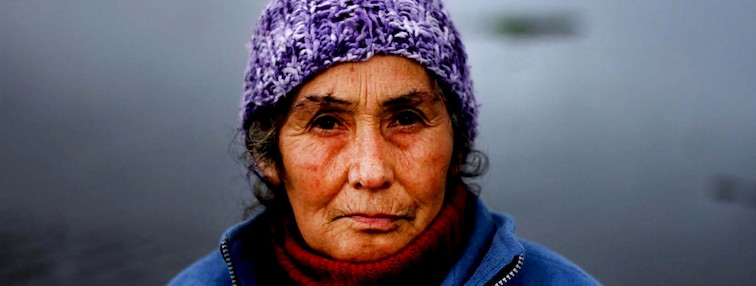
Cabe mencionar que, entre las distintas ocupaciones primarias que componen el rubro de la pesca artesanal, es decir, algueros, armadores, buzos, pescadores, entre otros, las mujeres tienen una importante presencia en todas ellas, siendo más predominante su empleabilidad entre las algueras y las pescadoras [2] [1] [3]. Además, en las comunidades costeras las mujeres se dedican a actividades conexas, entre las que están las de encarnado, charqueado, ahumado, desconchado y de tejido de red [1].
It is worth mentioning that, among the different primary occupations that make up the artisanal fishing sector, such as seaweed collectors, boat owners, divers, fishermen, among others, women have a significant presence in all of them, with their employability being more predominant among seaweed collectors and fishermen [2] [1] [3]. Additionally, in coastal communities, women engage in related activities, including processing, smoking, salting, shucking, and net weaving [1].
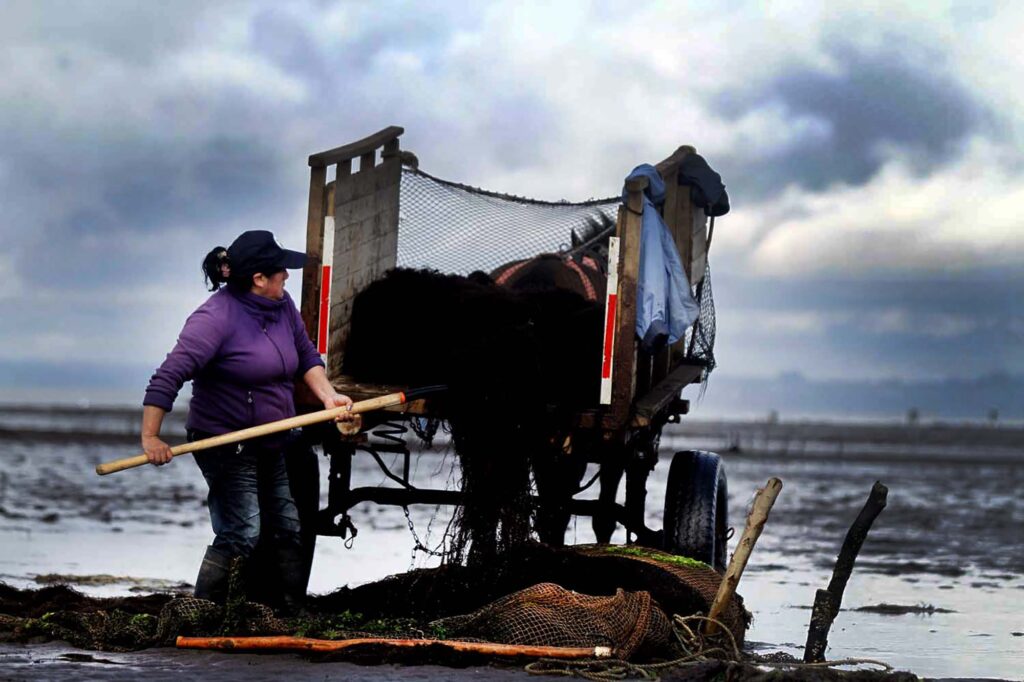
Actividades conexas de la pesca artesanal. Secado de algas. (Fuente: www.subpesca.cl/).
Activities related to artisanal fishing. Seaweed drying. (Source: www.subpesca.cl/).
Ante este crecimiento sostenido en el sector y en el empleo femenino que este proporciona, el Gobierno de Chile, a través de la Dirección de Obras Portuarias (DOP), servicio dependiente del Ministerio de Obras Públicas, ha puesto todos sus esfuerzos para estar a la altura y proporcionar servicios de infraestructura costera no sólo de calidad y con los mejores estándares de seguridad e higiene, sino que también consideren las necesidades de las mujeres que ahí trabajan. Esto, para incentivar el empleo femenino y facilitar la conciliación del trabajo con la vida familiar, y a su vez, garantizar condiciones óptimas para las labores que realizan en las caletas pesqueras artesanales.
En esa línea, la DOP diagnosticó que el rubro de la pesca artesanal ha estado enfocado principalmente, tanto en la administración de las caletas como en los diseños de estas, hacia los hombres. Esto, ya que muchas de ellas no cuentan con servicios higiénicos para mujeres, y no tienen las condiciones de infraestructura adecuada para las labores que ellas realizan o espacios destinados a actividades propias de las mujeres, como la lactancia.
Con la problemática de un sector productivo que se vuelve cada vez más grande y relevante para la economía nacional, y al cual están accediendo cada vez más mujeres, pero que no está acondicionado para el trabajo femenino, la DOP se sumó al Plan “Chile para Todas”. Este es el Plan del Gobierno del presidente Gabriel Boric que busca dignificar la vida diaria de las mujeres en Chile mediante una agenda integral [7].
Para esto, la DOP desarrolló una medida mediante la cual busca implementar infraestructura portuaria con enfoque de género en 12 caletas pesqueras artesanales distribuidas en cinco regiones del país [8]. Estas caletas tienen un espacio diseñado especialmente para mujeres, de modo que tengan un lugar propicio para desarrollar su actividad y puedan protegerse de las condiciones climáticas cuando ejerzan sus labores al interior de las caletas. Así, estas obras están destinadas a entregar condiciones espaciales, sociales, sanitarias y seguras para facilitar, potenciar y visibilizar el desarrollo de las actividades que realizan las mujeres de la pesca, a fin de favorecer el empoderamiento y autonomía económica de éstas. Por lo tanto, los diseños para estas obras incorporan elementos de base como baños, camarines, salones multiuso, salas de lactancia, y espacios destinados al trabajo singular de las mujeres en este rubro, según sea la ubicación geográfica, como galpones o sombreaderos para el encarnado, reparación de redes, desconchado, secado de algas, entre otras.
Given this sustained growth in the sector and in female employment it provides, the Chilean government, through the Direction of Port Works (Dirección de Obras Portuarias – DOP), a service under the Ministry of Public Works, has made every effort to provide coastal infrastructure services that not only meet the best standards of quality, safety, and hygiene but also consider the needs of the women working there. This is to promote female employment and facilitate the reconciliation of work with family life, as well as to guarantee optimal conditions for the work they perform in the coves.
In this regard, the Directorate of Port Works has diagnosed that the artisanal fishing sector has been focused primarily on men in both the management and design of the coves. This is because many of them do not have sanitary facilities for women, and do not have the appropriate infrastructure conditions for the work they perform or spaces designated for women’s activities, such as breastfeeding.
With the challenge of a productive sector that is becoming increasingly larger and more relevant to the national economy, and to which more and more women are gaining access, but which is not adapted to female work, the DOP has joined the “Chile para Todas” Plan. This is the Plan of President Gabriel Boric’s government that seeks to dignify the daily life of women in Chile through a comprehensive agenda [7].
To this end, the DOP has developed a measure aimed at implementing gender-focused port infrastructure in 12 artisanal fishing coves distributed in five regions of the country [8]. These coves have a space designed especially for women, so that they have a suitable place for the development of their activity and can protect themselves from the climatic conditions when they carry out their work inside the coves. Thus, these works are intended to provide spatial, hygienic, and sanitary conditions adequate to enhance the development and visibility of the activities carried out by women, aiming to promote the empowerment and economic autonomy of women in fishing. In this way, the designs for these works incorporate elements such as bathrooms, changing rooms, sheds, dressing rooms, nurseries for children, as well as spaces designated for activities carried out by women, such as processing, net repair, algae drying, among others.
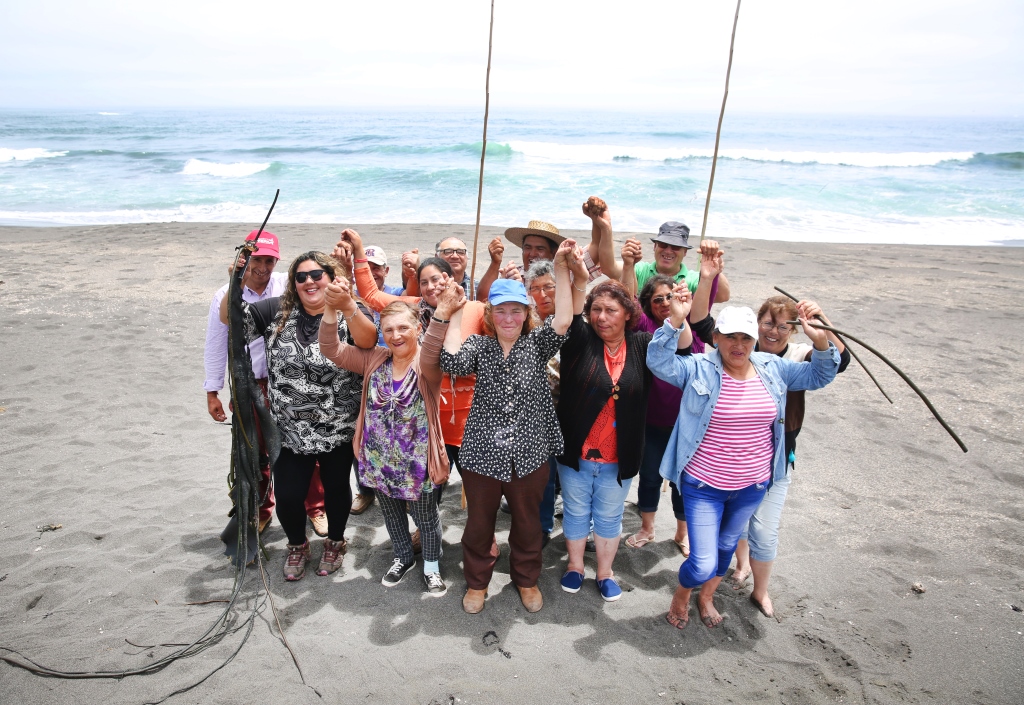
Agrupación de mujeres pescadoras y de actividades conexas. (Fuente: www.subpesca.cl/).
Group of women fishers and related activities. (Source: www.subpesca.cl/).
Para las actividades conexas que se realizan en las caletas esta misión cobra especial relevancia, ya que en algunos casos el rol de las mujeres en estas corresponde a un valor patrimonial, dado que estas labores se relacionan a oficios tradicionales cuya técnica ha sido traspasada de generación en generación y se han constituido como saberes ancestrales para las localidades en donde se ejercen.
A este objetivo, no obstante, también ha adherido todo el Ministerio de Obras Públicas, que, junto con sus distintas direcciones, ha asumido la tarea encomendada por el Presidente para avanzar hacia la igualdad de género. Así lo comenta el Director General de Obras Públicas, Boris Olguín: “En el gobierno del Presidente Boric tenemos el desafío de hacernos cargo de las brechas de género, por eso desde la Dirección General de Obras Públicas estamos trabajando para construir obras que busquen la integración social con un claro enfoque en mujeres, ya sea en aeropuertos, caminos, edificación pública y también en las caletas y bordes costeros. Como Ministerio tenemos toda una línea de trabajo para incorporar la perspectiva de género, la que parte con las consultas y participación ciudadana que se realizan en cada una de las localidades, donde se recogen las necesidades y desafíos de sus habitantes, para luego plasmarla en la construcción de las caletas artesanales. Estamos trabajando fuertemente en el compromiso de “Chile para Todas”, porque estamos convencidos que es la única manera de construir un mejor país”.
Respecto a las caletas pesqueras con enfoque de género, para el Director Nacional de la Dirección de Obras Portuarias, Ricardo Trigo, estas son fundamentales para el desarrollo económico de los lugares en los que se emplazan. “Son obras que buscan democratizar la pesca artesanal como actividad productiva, ya que están destinadas a potenciar el trabajo de todas y todos quienes viven en torno a esta labor. Estas caletas, al entregar condiciones que nosotros entendemos como básicas, como baños, camarines, galpones, vestidores, guarderías para niños y áreas para que se realicen ciertas labores específicas, como la reparación de redes o el secado de algas, pretenden entregar condiciones higiénicas y sanitarias con espacios adecuados para que las mujeres de la pesca desarrollen sus labores con buena calidad”.
En el diseño de esta medida, la DOP ha entablado relaciones con distintas entidades de la sociedad civil, y ha sostenido intercambios con la ciudadanía y organizaciones de pescadoras para conocer sus necesidades y plasmar las soluciones en los diseños de las caletas.
En total, se estima que las doce caletas, que estarán emplazadas a lo largo de Chile y en localidades de características geográficas y climáticas distintas, beneficiarán 784 pescadoras y a 300 personas, que se dedican a actividades conexas, principalmente mujeres. Los beneficiados de forma indirecta, en tanto, ascienden hasta las 400 mil personas.
For the related activities carried out in the coves, this mission is particularly relevant, as in some cases the role of women in these activities corresponds to a heritage value. This is because these activities correspond to traditional trades whose techniques have been passed down from generation to generation and have become ancestral knowledge for the localities where they are practiced.
To this end, however, the entire Ministry of Public Works has also joined, which, along with its various departments, has taken on the task entrusted by the President to advance gender equality. This is commented on by the General Director of Public Works, Boris Olguín: “In President Boric’s government, we have the challenge of addressing gender gaps, which is why from the General Directorate of Public Works we are working to construct projects that seek social integration with a clear focus on women, whether in airports, roads, public buildings, and also in fishing coves and coastal promenades. As a Ministry, we have a whole line of work to incorporate the gender perspective, which starts with consultations and citizen participation carried out in each locality, where the needs and challenges of its inhabitants are gathered, to then translate them into the construction of artisanal fishing coves. We are working hard on the commitment to ‘Chile para Todas’ Plan, because we are convinced that it is the only way to build a better country”.
Regarding fishing coves with a gender perspective, for the National Director of the Direction of Port Works, Ricardo Trigo, these are fundamental for the economic development of the places where they are located. “These are projects that seek to democratize artisanal fishing as a productive activity, as they are intended to enhance the work of all those who live around this activity. These coves, by providing what we understand as basic conditions, such as bathrooms, changing rooms, sheds, dressing rooms, nurseries for children, and areas for specific tasks, such as net repairs or seaweed drying, aim to provide hygienic and sanitary conditions with adequate spaces so that women in fishing can carry out their tasks with good quality”.
In the design of this measure, the DOP has established relationships with various civil society entities, and has held exchanges with citizens and fisherwomen’s organizations to understand their needs and incorporate solutions to these needs into the designs of the coves.
In total, it is estimated that the twelve coves, which will be located throughout Chile and in localities with different geographical and climatic characteristics, will benefit 784 fisherwomen and 300 people engaged in related activities, mainly women. The indirectly benefited, meanwhile, amount to 400 thousand people.
Mujeres en actividades conexas de la pesca artesanal. Desconchado de moluscos. (Fuente: www.subpesca.cl/).
Women in activities related to artisanal fishing. Shelling of mollusks. (Source: www.subpesca.cl/).
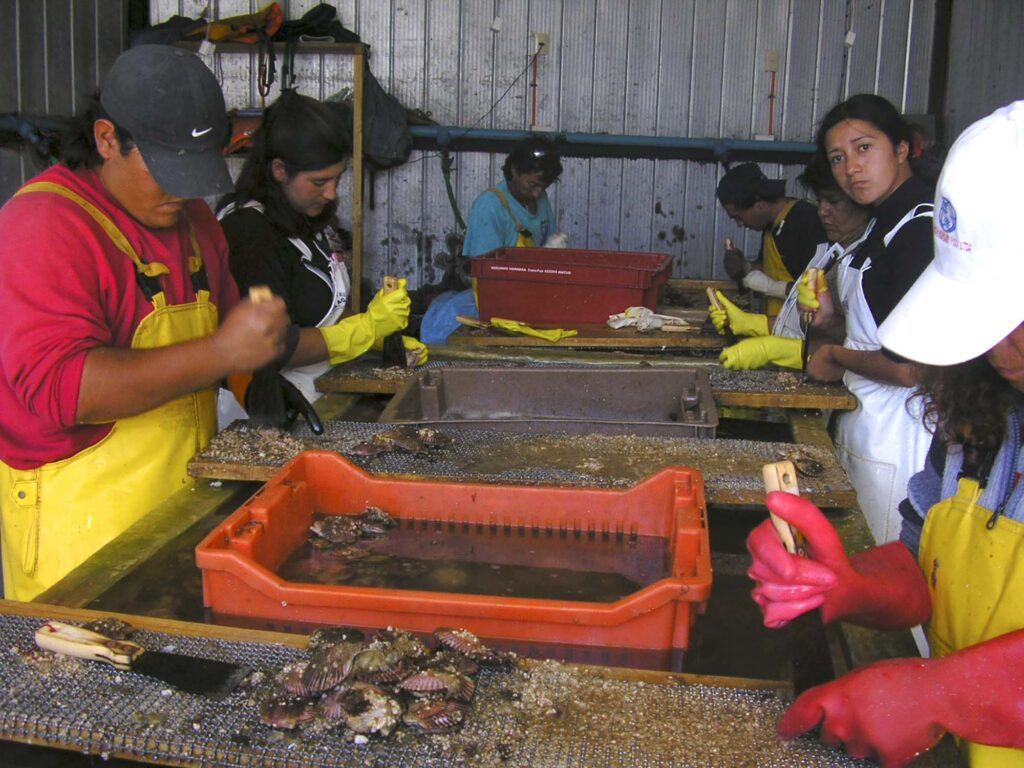
Otro factor relevante que amenaza al trabajo en las caletas en general y, particularmente, impacta más al que realizan las mujeres, es la crisis climática. De acuerdo con la Organización de las Naciones Unidas “la discriminación que aún sufren a nivel socioeconómico intensifica las consecuencias que el calentamiento global está teniendo sobre su alimentación, hogar y medios de vida” [6]. De esta forma, las mujeres que viven y trabajan en el borde costero no son la excepción, ya que conviven con eventos climáticos como marejadas, aumento del nivel del mar y cambios en la fauna marina que luego recolectan o pescan, según sea su ocupación.
En esa línea la DOP considera en sus obras la adaptación y mitigación a los efectos de la crisis climática y busca resguardar de los fenómenos climáticos adversos a las comunidades costeras, así como a los sectores productivos que se verían afectados. Así, atendiendo a las condiciones cambiantes de un sector productivo que está creciendo y abriendo la puerta al trabajo femenino, la DOP busca otorgar obras de infraestructura que puedan potenciar el desarrollo económico de las localidades en las que se asientan y garantizar que sean funcionales tanto a mujeres como hombres, para dar resguardo a las comunidades ante la crisis climática.
En síntesis, el auge de la pesca artesanal en Chile ha transformado un sector antes local y tradicional en un motor económico nacional y territorial, con crecimiento sostenido en desembarques y empleo, especialmente femenino. Sin embargo, la infraestructura portuaria no ha evolucionado al mismo ritmo, evidenciando carencias para las trabajadoras. El Plan “Chile para Todas” y la iniciativa de la DOP apuntan a corregir estas brechas, con obras adaptadas a las necesidades de las mujeres, fomentando su empoderamiento y garantizando condiciones laborales adecuadas. Estas acciones no solo benefician a las pescadoras y actividades conexas, sino que también fortalecen la resiliencia de las comunidades costeras ante los desafíos de la crisis climática. Es así como, mediante una mirada inclusiva y sustentable, se puede potenciar el desarrollo económico y social de Chile, asegurando que nadie quede atrás en este proceso de transformación.
Another relevant factor that threatens work in the coves in general and, particularly, impacts more on women is the climate crisis. According to the United Nations, “the discrimination they still suffer at the socio-economic level intensifies the consequences that global warming is having on their food, home, and livelihoods” [6]. In this way, women living and working on the coast are no exception, as they live with climatic events such as swells, sea level rise, and changes in marine fauna that they later collect or fish, depending on their occupation.
In this line, the DOP considers in its works the adaptation and mitigation to the effects of the climate crisis and seeks to protect coastal communities from adverse climatic phenomena, as well as productive sectors that would be affected. Thus, attending to the changing conditions of a productive sector that is growing and opening the door to female work, the Directorate of Port Works seeks to provide infrastructure works that can enhance the economic development of the localities where they are located and guarantee that they are functional for both women and men, as well as providing protection to the communities against the climate crisis.
In summary, the rise of artisanal fishing in Chile has transformed a previously local and traditional sector into a national and territorial economic engine, with sustained growth in landings and employment, especially for women. However, port infrastructure has not evolved at the same pace, revealing deficiencies for female workers. The “Chile para Todas” Plan and the DOP initiative aims to correct these gaps, with works adapted to women’s needs, promoting their empowerment, and ensuring adequate working conditions. These actions not only benefit female fishermen and related activities but also strengthen the resilience of coastal communities against the challenges of the climate crisis. Thus, through an inclusive and sustainable approach, economic and social development in Chile can be enhanced, ensuring that no one is left behind in this transformation process.
Mujeres pescadoras recolectoras de orilla. (Fuente: www.subpesca.cl/).
Fisherwomen collecting from the shore. (Source: www.subpesca.cl/).
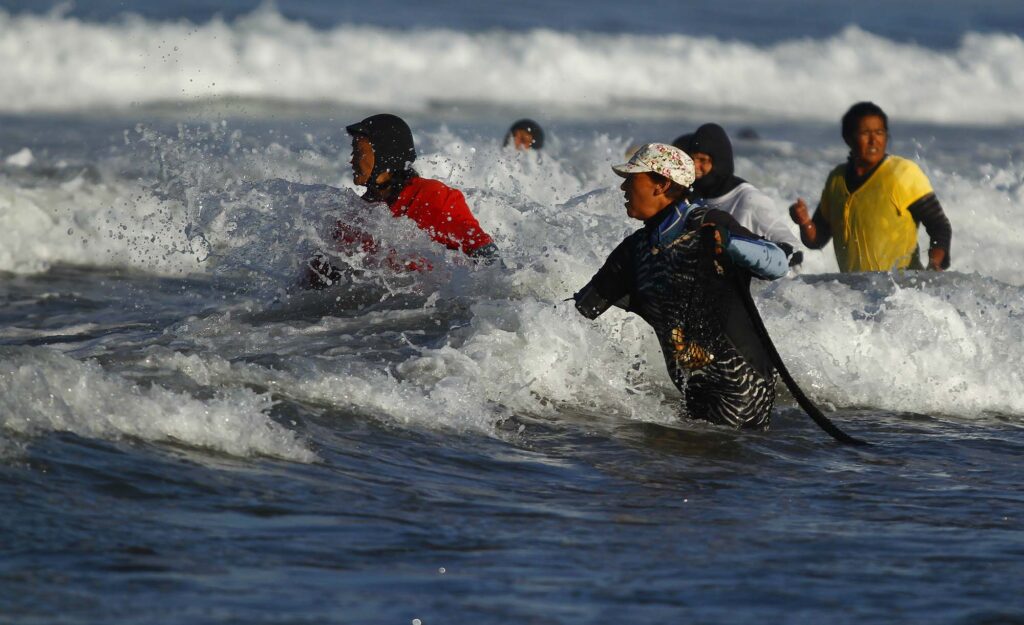
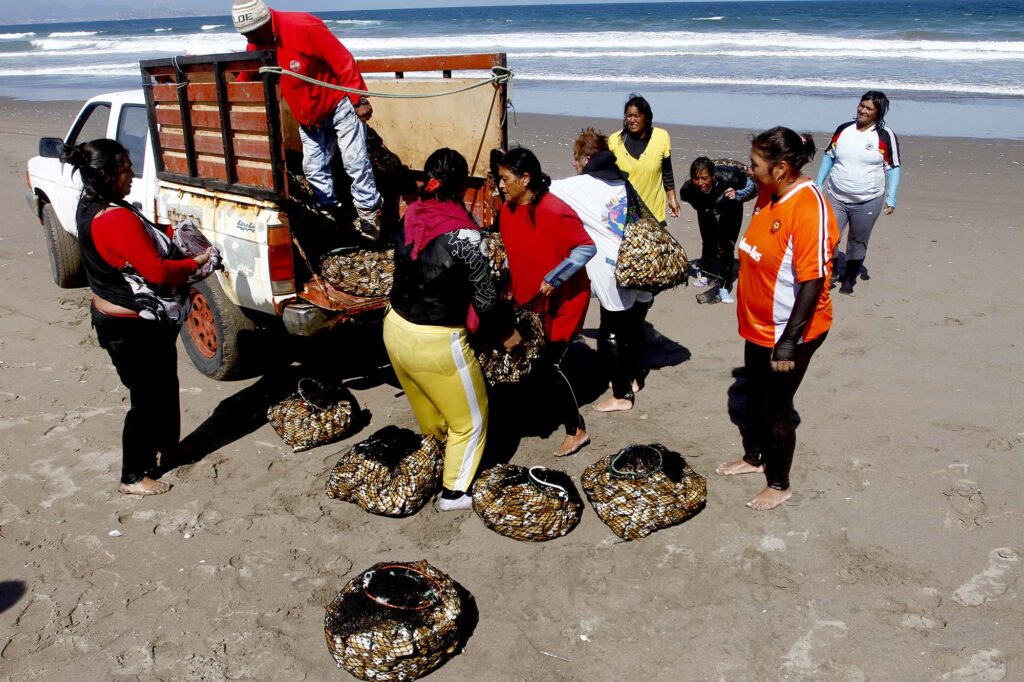
IMAGEN INICIAL | Caleta de pesca artesanal de Tongoy, Región de Coquimbo, Chile. (Fuente: www.subpesca.cl/).
HEAD IMAGE | Artisanal fishing cove of Tongoy, Coquimbo region, Chile. (Source: www.subpesca.cl/).
╝
NOTAS
NOTES
[1] Estadísticas de la industria pesquera artesanal (2022): https://www.sernapesca.cl/app/uploads/2023/09/2022_030201_subsector_artesanal_v20220905.pdf/.
[2] Estadísticas de la industria pesquera artesanal (2017): https://www.sernapesca.cl/app/uploads/2023/11/subsector_artesanal_2017-1.pdf/.
[3] Estadísticas de la industria pesquera artesanal (2012): https://www.sernapesca.cl/app/uploads/2023/11/2012_subsector_artesanal_0.pdf/.
[4] Información sobre el estado actual de la industria pesquera artesanal en Chile: https://www.subpesca.cl/portal/616/w3-article-645.html/.
[5]https://www.gob.cl/nuestropais/#:~:text=Chile%20tiene%20una%20costa%20de,espacio%20mar%C3%ADtimo%2C%20llamado%20Mar%20chileno/.
[6]https://news.un.org/es/story/2020/06/1475742/
[7] Información sobre el Plan “Chile para Todas”: https://www.gob.cl/chileparatodas/.
[8] Información sobre las 12 caletas de pesca con inclusión de género: https://minmujeryeg.gob.cl/?p=49596#/.
[1] Statistics on the artisanal fishing industry (2022): https://www.sernapesca.cl/app/uploads/2023/09/2022_030201_subsector_artesanal_v20220905.pdf/.
[2] Statistics on the artisanal fishing industry (2017): https://www.sernapesca.cl/app/uploads/2023/11/subsector_artesanal_2017-1.pdf/.
[3] Statistics on the artisanal fishing industry (2012): https://www.sernapesca.cl/app/uploads/2023/11/2012_subsector_artesanal_0.pdf/.
[4] Information about the current state of the artisanal fishing industry in Chile: https://www.subpesca.cl/portal/616/w3-article-645.html/.
[5]https://www.gob.cl/nuestropais/#:~:text=Chile%20tiene%20una%20costa%20de,espacio%20mar%C3%ADtimo%2C%20llamado%20Mar%20chileno/.
[6]https://news.un.org/es/story/2020/06/1475742/
[7] Information about the “Chile para Todas” Plan: https://www.gob.cl/chileparatodas/.
[8] Information about the 12 gender inclusive fishing coves: https://minmujeryeg.gob.cl/?p=49596#/.
REFERENCIAS
REFERENCES
Subsector pesquero artesanal (2012), Servicio Nacional de Pesca y Acuicultura, Valparaíso, Chile.
Subsector pesquero artesanal (2017), Servicio Nacional de Pesca y Acuicultura, Valparaíso, Chile.
Subsector pesquero artesanal (2022), Servicio Nacional de Pesca y Acuicultura, Valparaíso, Chile.
“La desigualdad de género le da ventaja al cambio climático”, Noticias ONU, 9 junio 2020, https://news.un.org/es/story/2020/06/1475742/.
“Chile para Todas”, Gobierno de Chile, https://www.gob.cl/chileparatodas/.
“Ministra de la Mujer y Equidad de Género dialogó con mujeres de la pesca artisanal y actividades conexas en Caleta Los Molinos en Valdivia”, Ministerio de la Mujer y la Equidad de Género, 21 febrero 2023, https://minmujeryeg.gob.cl/?p=49596#/.